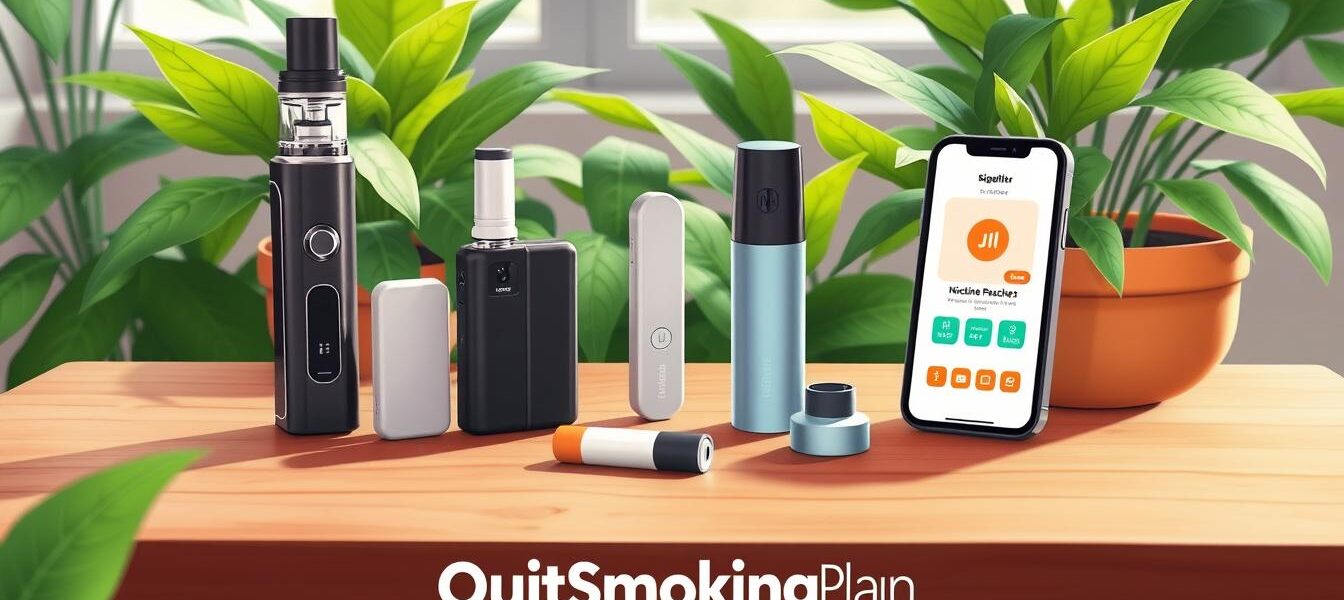“Quitting smoking is difficult; not quitting is fatal.” Dr. A. J. McClaron’s words highlight the dangers of smoking. Starting your journey to a healthier life? Knowing about quit smoking gadgets can help a lot. With only 5% of people quitting without help, finding the right tools is key1.
We’ll show you the best quit smoking devices and online support apps. These tools are made for your needs. Learning about them is the first step to beating nicotine and getting healthier.
Key Takeaways
- Exploring *quit smoking gadgets* improves your chances of success.
- Only about 5% of smokers quit successfully without any support1.
- Utilizing the *best quit smoking devices* can provide essential help in quitting.
- Understanding *quit smoking products* can lead to healthier lifestyle choices.
- Combining gadgets with behavioral support can enhance cessation efforts1.
Introduction to Quit Smoking Gadgets
In today’s fast world, quit smoking gadgets have become key in fighting nicotine addiction. The world of quitting smoking has grown, offering new devices and old methods. These tools aim to help you live without cigarettes.
Studies show these gadgets work well. Quitting smoking early can cut your risk of death by 50% in 15 years2. In the UK, many have quit smoking with e-cigarettes3. Nicotine patches can boost success rates by over 50% with intensive therapy2.
Modern quit smoking products are needed because smoking is so dangerous. Nicotine is very addictive. Using aids can make quitting easier. Knowing how technology helps can boost your chances of quitting.
When picking gadgets, choose what fits your needs and likes. Options range from e-cigarettes to nicotine patches. Using these tools can greatly improve your chances of beating addiction.
Understanding Smoking Cessation
Quitting smoking is a huge step towards better health. It can lower the risk of serious diseases like cancer and heart disease. There are many resources and technologies to help you quit. Using the right devices can boost your chances of success.
Importance of Quitting Smoking
Deciding to quit smoking can change your health for the better. Quitting early can prevent chronic diseases and improve your life quality. Many believe that using NRTs or other products for 12 weeks can help you quit4.
Getting advice from professionals who can find the right product for you is crucial4.
Statistics on Smoking and Cessation Success Rates
Many people quit smoking on their own, but getting help can make it easier. Nicotine-free medicines work by blocking nicotine’s effects in the brain4. Nicotine vapes are seen as helpful for adult smokers trying to quit4.
But, using both e-cigarettes and tobacco is risky and should be done carefully5. Research shows that quitting is harder without support. Local Stop Smoking Services offer valuable help, either in person or online4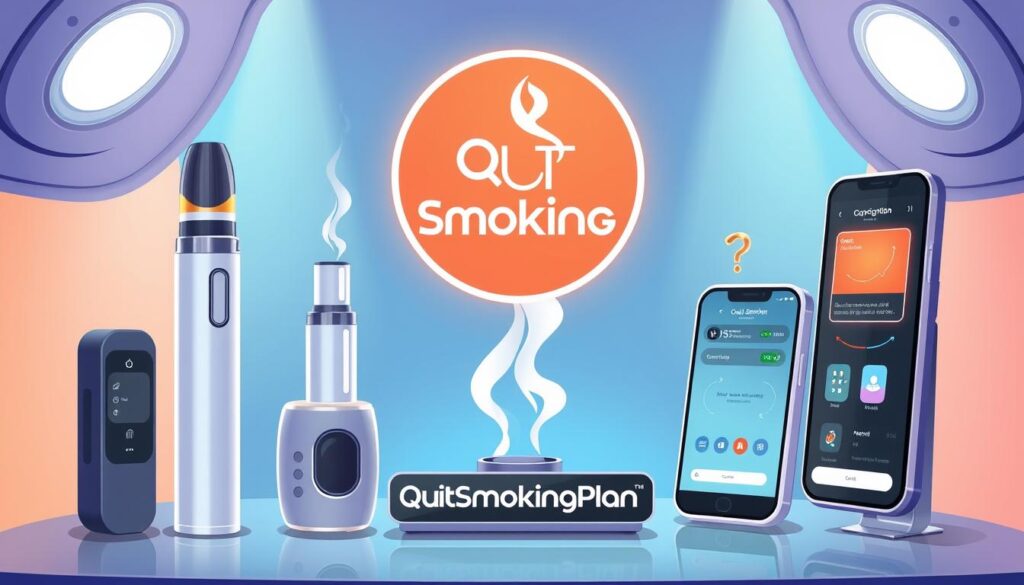
Types of Quit Smoking Gadgets
Choosing to quit smoking opens up a world of gadgets to help you. These tools are made to make quitting easier by tackling cravings and withdrawal. They come in two main types: Nicotine Replacement Therapy (NRT) products and prescription meds.
Overview of Different Categories
Nicotine Replacement Therapy products are very popular. They give your body nicotine to ease cravings and symptoms without the bad stuff in cigarettes. You can find options like patches, gums, lozenges, nasal sprays, and inhalers over-the-counter or by prescription6.
Non-nicotine prescription meds like Bupropion and Varenicline also help. They manage cravings and make nicotine less appealing to your brain76.
How Each Category Works
Each type of quit smoking gadget has its own way of helping you quit. NRT products, like gums and patches, release nicotine slowly. This helps you gradually get off cigarettes6.
Prescription meds, like Bupropion and Varenicline, are used for a few weeks or more. A doctor will prescribe them. They help with withdrawal and can increase your chances of staying smoke-free7.
Nicotine Replacement Therapy Products
Nicotine Replacement Therapy (NRT) offers many quit smoking gadgets. These gadgets help people stop smoking by giving them nicotine in small amounts. This way, they can fight cravings without the bad stuff in cigarettes. You can buy these products over-the-counter or get a prescription. They help you slowly get off nicotine.
What is Nicotine Replacement Therapy (NRT)?
NRT gives nicotine in small doses to help with withdrawal and cravings. Studies show that FDA-approved NRT products can double your chances of quitting smoking18. You can buy nicotine patches, gum, and lozenges without a doctor’s note. But, talking to a doctor can help you quit better and get support.
Types of NRT Products Available
There are many NRT products for different needs:
- Nicotine Patches: These give nicotine all day, helping with cravings and withdrawal. They might cause skin irritation or vivid dreams.
- Nicotine Gum: Chewing up to 24 pieces a day helps with cravings. You might get mouth or jaw soreness.
- Nicotine Lozenges: These dissolve in your mouth, helping with cravings without chewing. They’re good for people with dental appliances.
- Nicotine Inhaler: This is by prescription and lets you inhale nicotine. It might cause mouth or throat irritation.
- Nicotine Nasal Spray: This works fast but can irritate your nose and throat. You need a prescription.
There are also prescription meds like bupropion and varenicline to help quit smoking8. Using these NRT products with professional help makes a strong plan to stop smoking.
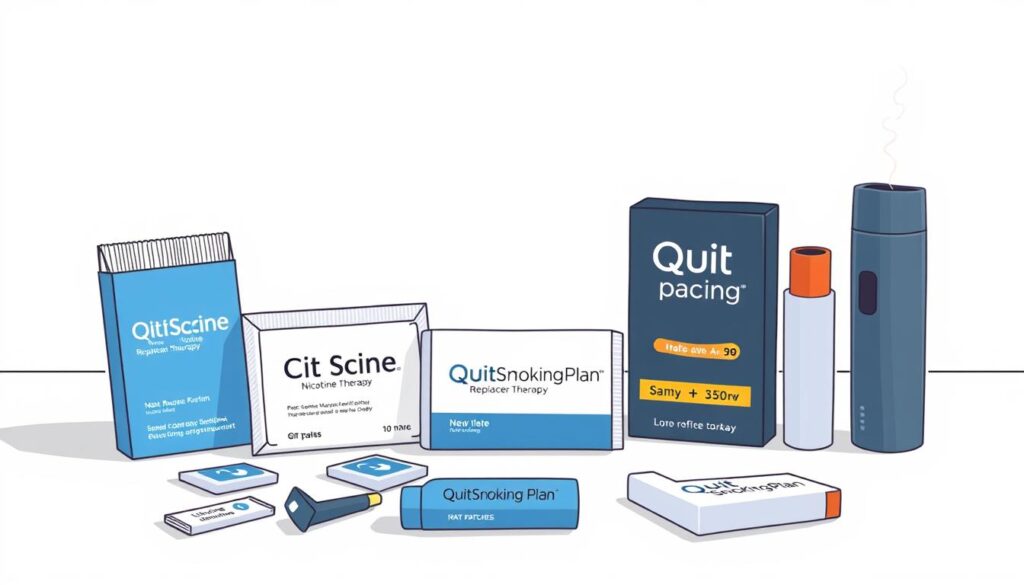
Top Quit Smoking Gadgets Available Today
Starting your journey to quit smoking? The best gadgets can really help. They offer physical support and motivation through technology. Let’s look at top devices that have helped many.
Detailed Reviews of Leading Devices
1. Nicotine Patch: It slowly releases nicotine through your skin, helping with cravings. You need to change it every 24 hours. Many find it helps them quit better1.
2. Nicotine Gum: You can chew up to 24 pieces a day. It helps with cravings but might cause mouth irritation or nausea. It’s a popular choice for quitting1.
3. Varenicline (Chantix): This prescription drug reduces cravings and blocks nicotine receptors in the brain. It’s effective but can cause side effects like nausea and insomnia8.
4. Nicotine Inhaler: It releases nicotine vapor, helping you feel like you’re smoking. But, it might irritate your mouth or throat1.
Comparison of Effectiveness
Studies show FDA-approved products can double your chances of quitting8. Using these products with counseling can increase success even more. Here’s a table comparing their effectiveness, ease of use, and side effects:
| Device | Effectiveness | Ease of Use | Common Side Effects |
|---|---|---|---|
| Nicotine Patch | High | Easy | Skin irritation |
| Nicotine Gum | Moderate | Very Easy | Jaw soreness, heartburn |
| Varenicline | High | Moderate | Nausea, insomnia |
| Nicotine Inhaler | Moderate | Moderate | Mouth irritation |
Choosing the right gadget can greatly impact your fight against smoking addiction. Using these devices with professional help can increase your chances of success89.
Electronic Quit Smoking Devices
The world of quitting smoking is changing fast. Now, we have e-cigarettes and vapor pens leading the way. These devices use new tech to help people stop smoking. But, it’s important to think about their safety and if they really work.
Innovative Technologies in Smoking Cessation
E-cigarettes have changed how people quit smoking. They give nicotine in vapor, not smoke. This is why many people like them. But, the FDA hasn’t approved them as quit aids yet.
This has raised health and rule questions. E-cigarettes, especially flavors, have become very popular among young people. Over 2.1 million youth use them, making them the top tobacco choice for this age group10.

Pros and Cons of Using E-Cigarettes
- Pros: Some see e-cigarettes as a safer choice than regular cigarettes. They might help some people cut down on smoking.
- Cons: Using both e-cigarettes and regular cigarettes is very dangerous. People who use e-cigarettes every day are twice as likely to have heart attacks11. Even short-term use can harm lungs and breathing11.
Groups like the FDA keep watching these products. They’re worried about things like vape battery explosions. Big tobacco companies spend a lot on ads, over $8.2 billion in 2019. This makes it harder for young people to avoid these products10.
So, it’s key to know both the good and bad sides of e-cigarettes. This helps people make informed choices about using them.
To learn more about vaping risks, check out this resource.
Nicotine Patches: A Popular Choice
Nicotine patches are known to help people quit smoking. They release nicotine slowly into the body. This helps manage cravings and withdrawal symptoms12.
It’s important to stop smoking the day you start using the patch. Also, avoid other tobacco products to stay healthy12.
How Nicotine Patches Work
Nicotine patches are worn on the skin for 16 or 24 hours12. They release nicotine slowly, like smoking, but without harmful toxins. Make sure to change the patch daily and apply it to a new spot if it falls off12.
Benefits and Drawbacks
Nicotine patches can greatly reduce withdrawal symptoms, making quitting easier12. Many find high-dose patches more effective than lower-dose ones13. However, some might experience mild side effects like skin irritation or sleep issues1214.
Always talk to a healthcare professional before starting. They can help find the right patch for you and discuss any health concerns12.
Nicotine Gum: An Everyday Option
Nicotine gum is a helpful quit smoking aid. It helps with withdrawal symptoms when you try to stop smoking. It’s good for managing cravings all day long.
Usage Guidelines and Effectiveness
To get the most out of nicotine gum, follow the right usage. Chew it every 1 to 2 hours for the first six weeks. Then, adjust to every 2 to 4 hours for three weeks, and finally, every 4 to 8 hours for the last three weeks. This method can really help reduce cravings and withdrawal symptoms15 and16.
Studies show that nicotine gum can lessen the urge to smoke. Both 2mg and 6mg doses help a lot17 and16. Experts recommend using it with other quit smoking tools, like patches or lozenges, to boost your chances of quitting17.
Common Misconceptions About Nicotine Gum
Some people think nicotine gum leads to addiction. But this is rare because it has less nicotine and absorbs it slower than cigarettes15. You might feel mouth irritation, dizziness, or stomach issues, but these usually go away quickly15.
It’s important to remember that nicotine gum isn’t for everyone. People with heart problems, pregnant women, or breastfeeding moms should avoid it15. Talking to a doctor can clear up any doubts and help you find a quitting plan that works for you.
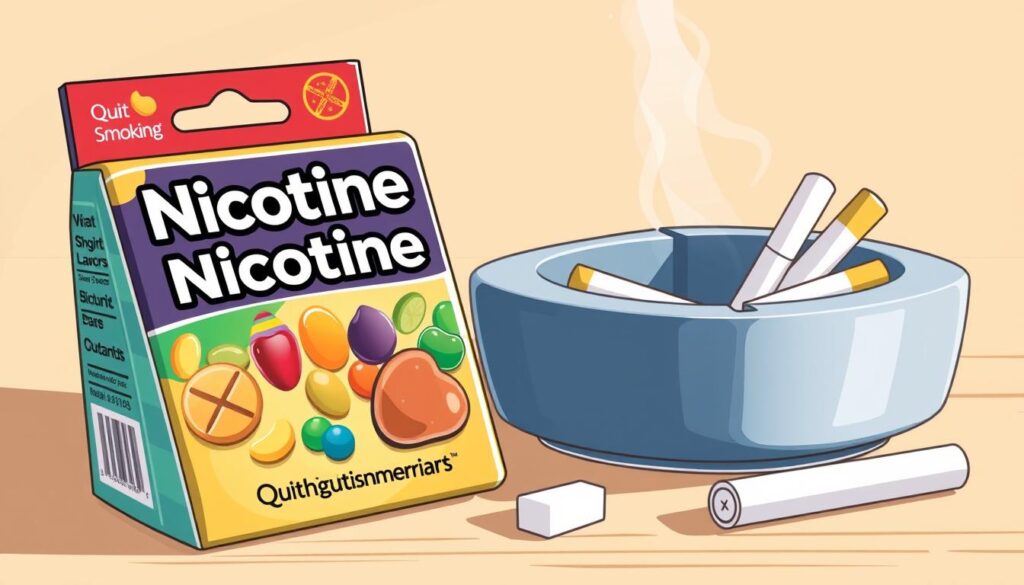
| Nicotine Gum Usage | Initial Phase (Weeks 1-6) | Middle Phase (Weeks 7-9) | Final Phase (Weeks 10-12) |
|---|---|---|---|
| Frequency | Every 1-2 hours | Every 2-4 hours | Every 4-8 hours |
| Potential Side Effects | Bad taste, mouth irritation | Dizziness, hiccups | Throat or jaw irritation |
| Dependence Risk | Low | Low | Low |
Knowing the truth about nicotine gum can help you make better choices in your quit smoking journey. Using nicotine gum can be a powerful tool to fight cravings and increase your chances of quitting for good15.
Innovative Smoking Cessation Gadgets
New gadgets are helping people quit smoking. These tools offer more than just traditional methods. They help users in ways that fit their needs. This makes quitting smoking easier and more personal.
Emerging Technologies in Smoking Cessation
New gadgets use advanced technology to help smokers. For instance, the QuitKey keyring helps users cut down on cigarettes. It has a plan tailored just for them.
The Quitbit smart lighter lets users track their smoking. It shows how often they light up. The Pavlok watch even gives mild shocks to stop smoking. This helps users break the habit18.
The Role of Behavioral Support with Gadgets
Combining gadgets with behavioral support makes quitting easier. Studies show that using gadgets with therapy works better than just one or the other. About 70% of smokers want to quit, showing the need for effective tools1918.
Using gadgets with behavioral support helps with both physical and mental aspects of quitting. It’s a complete approach to overcoming smoking.
| Device | Functionality | Type of Support |
|---|---|---|
| QuitKey | Gradual weaning off cigarettes | Behavioral support with structured plan |
| Quitbit Smart Lighter | Tracks smoking habits | Awareness and behavioral feedback |
| Pavlok Watch | Mild electric shocks to deter smoking | Conditioning support |
| Auricular Acupuncture Device | Acupuncture for cravings | Therapeutic support |
Prescription Medications for Quitting
Prescription medications can help a lot when you’re trying to quit smoking. Bupropion and varenicline are two FDA-approved drugs that can manage cravings and withdrawal. Knowing how they work can help you choose the right quit-smoking plan.
Bupropion: Reducing Withdrawal Symptoms
Bupropion, also known as Zyban, is an antidepressant that helps with nicotine cravings and withdrawal. It works best when used with nicotine patches17. It’s part of a comprehensive quit-smoking program20. Side effects include dry mouth, nausea, and dizziness. It can also increase the risk of seizures21.
It’s important to watch for interactions with other medications, especially for anxiety or heart conditions20.
Varenicline: Unique Mechanisms of Action
Varenicline, or Chantix, works by blocking nicotine receptors in the brain. This makes smoking less enjoyable and helps with withdrawal21. Studies show it works better with nicotine replacement therapy (NRT) than alone21. Side effects include nausea, headaches, and mood changes21.
Like bupropion, ongoing support and monitoring are key to quitting success20.

| Medication | Mechanism of Action | Common Side Effects | Combination Efficacy |
|---|---|---|---|
| Bupropion (Zyban) | Reduces cravings and withdrawal symptoms | Dry mouth, nausea, dizziness, seizure risk | Increases success when combined with NRT |
| Varenicline (Chantix) | Blocks pleasure from smoking and alleviates withdrawal | Nausea, headache, mood changes | More effective when used with NRT |
Using prescription medications with other quit-smoking strategies can greatly improve your chances of quitting211720.
Smartphone Apps as Quit Smoking Aids
Quit smoking technology has changed how we fight addiction. Now, smokers can track their progress and manage cravings with the help of apps. These tools are key in helping people quit, offering motivation and guidance every step of the way.
Overview of Popular Quit Smoking Apps
Kwit is a top app for quitting smoking, praised by the WHO. It uses behavioral and cognitive therapies to help users. This app tracks smoking habits, records cravings, and helps manage nicotine substitutes. It also offers motivational cards and an ad-free space to focus on your goals.
A study on the Stop-tabac app showed a 9.9% success rate after six months. This shows how effective these apps can be in helping you quit smoking22.
How Technology Enhances Support for Smokers
Technology makes quitting easier with tools designed to fight addiction. KICK IT has helped over 1 million people quit. Although it has some usability issues, like not allowing past quit dates, users find it helpful in reducing cravings and supporting vaping cessation23.
With an average rating of 4.5 out of 5, these apps improve quitting experiences. They also create a community where users can share their successes and challenges.
Evaluating the Effectiveness of Quit Smoking Tools
Choosing the right quit smoking gadgets is crucial. Not all tools work the same way. Factors like user reviews, ease of use, and satisfaction are important. Look closely at different options to find the best quit smoking gadgets.
What to Look for in Quit Smoking Gadgets
When checking out quit smoking tools, focus on these key points:
- User Reviews: What others say can help a lot.
- Ease of Use: Simple tools work better in your daily life.
- Integration with Other Methods: Gadgets that work with therapy are more effective.
- Personalization Options: Customizing your quit plan can help more.
Combining Gadgets with Behavioral Therapy
Studies show that using gadgets with therapy boosts success rates. Mobile apps for quitting smoking offer ongoing support. With over 350,000 health apps available, finding the right one is easier on the market24.
Tobacco kills over 480,000 people in the U.S. each year. Yet, 70% of smokers want to quit. Only a few succeed. Using gadgets with support can help you on this tough journey.
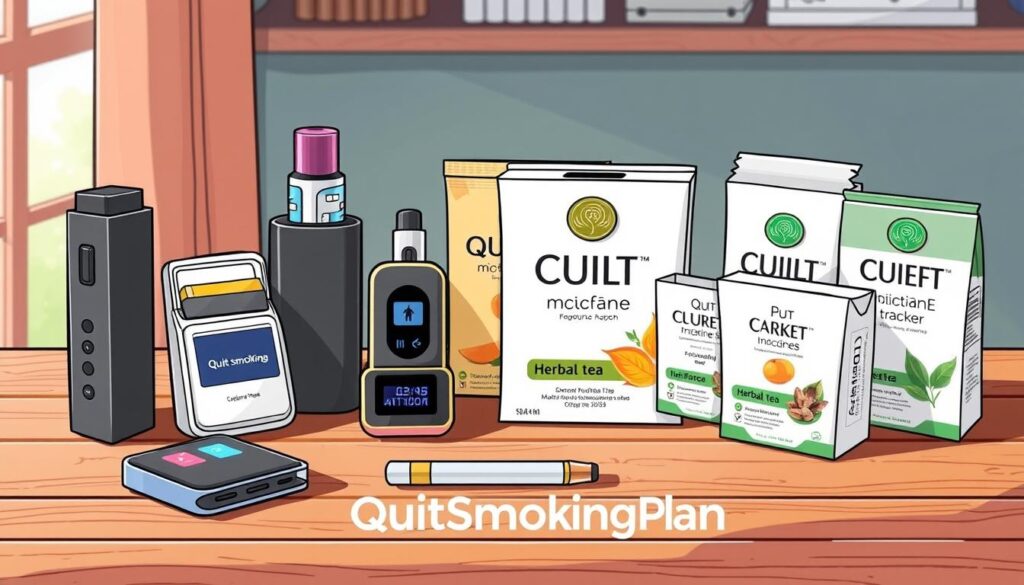
Resources for Smokers Looking to Quit
Trying to quit smoking is tough. But, many quit smoking resources and support groups are here to help. Here are some key organizations and tools that offer valuable support for smokers.
Organizations That Provide Support
Many smoking cessation organizations help those who want to quit. They offer resources like trained quit coaches and detailed programs.
- 1-800-QUIT-NOW: This helpline connects you with quit coaches for free, confidential support.
- EX Program: With over 15 years of experience, it has helped millions quit. Studies show it can increase quitting chances by up to 40%25.
Additional Reading and Tools
There are also many books and tools to help you quit smoking. Learning about medications that can double your chances of quitting is important. There are seven FDA-approved options available26.
Using medication and counseling together can greatly improve your chances of quitting. If you have respiratory health issues, it’s important to know about the dangers of using e-cigarettes with traditional cigarettes. Dual use can worsen health outcomes26.
| Resource | Key Benefit |
|---|---|
| 1-800-QUIT-NOW | Confidential help from trained coaches |
| EX Program | Increased odds of quitting by up to 40% |
| FDA-Approved Medications | Enhances quitting success rates |
These resources offer the support and guidance you need for a smoke-free life. They help create an environment for lasting change26.
Quit Smoking Gadgets Reviews
Finding the best tools to quit smoking is easier with consumer feedback. Real users share their experiences, helping you understand what works. Each device has its own strengths, helping people fight nicotine addiction.
Consumer Feedback on Various Products
Many have shared their stories with the top quitting devices. Nicotine patches and gum have boosted quit rates by 50 to 70%16. Nicotine gum, for example, helps reduce cravings, especially with higher doses16.
Electronic cigarettes are also discussed. Some find them useful for cravings, but others doubt their quitting power27.
Expert Opinions
Experts suggest using dual nicotine replacement therapy (NRT) for better success, with a 12 in 100 success rate28. Varenicline is highly rated for blocking nicotine receptors and easing withdrawal16. They stress that quitting aids are just part of the solution. Personal commitment and support are key too.
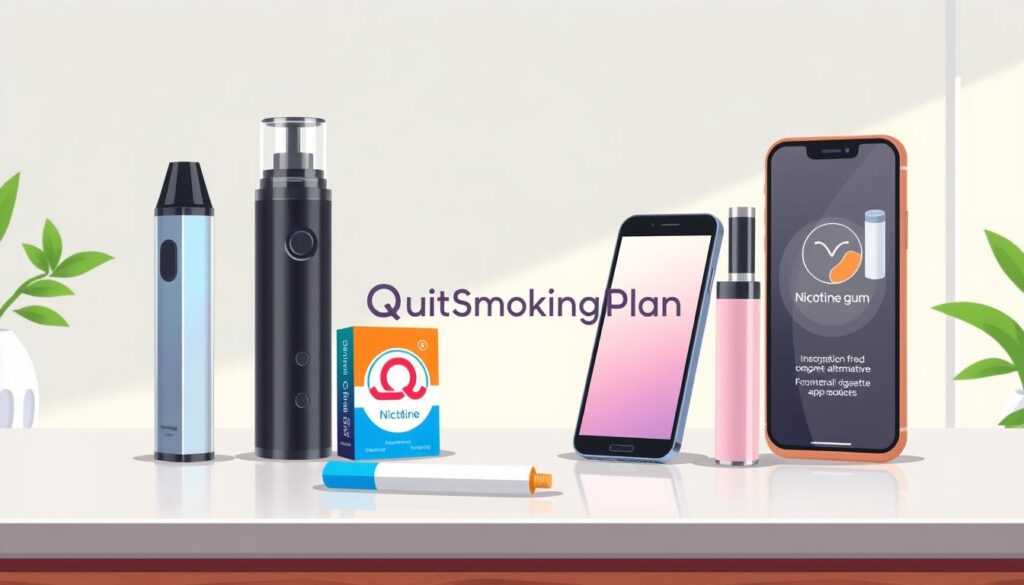
Considerations Before Choosing a Quit Smoking Product
Choosing the right quit smoking product is a big step towards being tobacco-free. Getting advice from a health professional is key. They help find quitting strategies that fit your needs. It’s important to know what works best for you.
Consulting Healthcare Professionals
It’s wise to talk to a healthcare professional before you start quitting. Studies show that 80% of people can benefit from help from counselors. They can suggest things like nicotine replacement therapy and other treatments29.
They also consider your health. Some health issues might affect what quitting strategies are best for you.
Evaluating Personal Needs and Preferences
Finding what works for you is crucial when picking quit smoking products. Things like how many times you’ve tried to quit and what you prefer can help. For example, you might like nicotine gum, lozenges, or patches30.
Understanding your habits and what triggers you can help you focus on the right approach. This makes your quitting journey more personal and effective.
The Future of Smoking Cessation Technology
The world of quitting smoking is changing fast with new products. Science keeps finding better ways to help people stop smoking. Knowing about these changes can help you find new ways to quit.
Advancements in Quit Smoking Products
Scientists are working on tech to help people stop smoking. A study found 639 articles on this topic from 2003 to 2022. This shows a big interest in digital help for quitting31.
People using apps, texts, and social media say it helps them quit. New ideas like virtual reality and tools for different groups are coming up. These could be big help in the future31.
Predictions for Smoking Cessation Gadgets
We’ll see more smart tech that uses AI to help people quit. For example, the Smart-T2 app helped 22% of users stay smoke-free for 12 weeks32. As more people learn about these tools, they’ll play a big role in helping smokers quit. This is important for the 44 million Americans who want to stop smoking33.
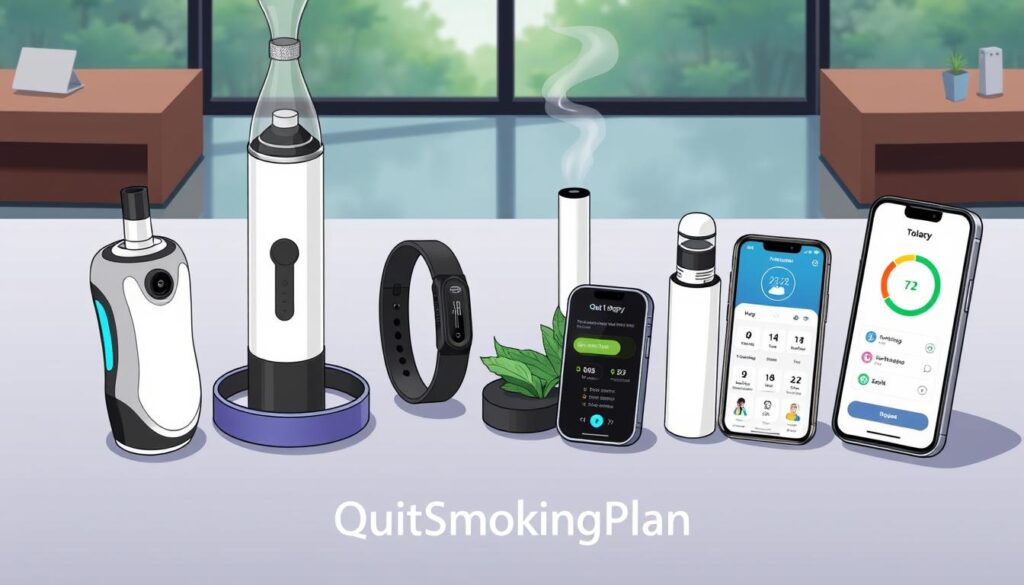
Conclusion
When you’re trying to quit smoking, it’s key to see how quit smoking gadgets can help. These tools offer support and resources to boost your chances of quitting. They come in many forms, like nicotine replacement, mobile apps, and electronic devices, each with its own benefits.
Studies show that nicotine e-cigarettes might help people quit better than traditional methods34. This highlights the importance of using different quit smoking aids. By trying out various gadgets, you can find what works best for you.
Quitting smoking is a big step, but you’re not alone. There are many resources and gadgets to help you. With the right tools and determination, you can live a healthier life without smoking.
FAQ
What are quit smoking gadgets?
How effective are quit smoking products?
What is Nicotine Replacement Therapy (NRT)?
Are electronic quit smoking devices safe to use?
Can I use nicotine patches with other cessation aids?
What role do smartphone apps play in quitting smoking?
How do I choose the right quit smoking gadget for me?
What are the side effects of nicotine gum?
How can I increase my success rate when quitting smoking?
Source Links
- https://www.mayoclinic.org/healthy-lifestyle/quit-smoking/in-depth/quit-smoking-products/art-20045599
- https://www.uptodate.com/contents/quitting-smoking-beyond-the-basics
- https://www.nhs.uk/live-well/quit-smoking/using-e-cigarettes-to-stop-smoking/
- https://www.nhs.uk/better-health/quit-smoking/ready-to-quit-smoking/find-the-best-stop-smoking-products-for-you/
- https://www.cancer.org/cancer/risk-prevention/tobacco/guide-quitting-smoking/other-ways-to-quit-smoking.html
- https://www.fda.gov/consumers/womens-health-topics/smoking-medicines-help-you-quit
- https://www.heart.org/en/healthy-living/healthy-lifestyle/quit-smoking-tobacco/help-i-want-to-quit-smoking
- https://www.fda.gov/consumers/consumer-updates/want-quit-smoking-fda-approved-and-fda-cleared-cessation-products-can-help
- https://www.allencarr.com/easyway-stop-smoking/stop-smoking-treatments/
- https://www.heart.org/en/healthy-living/healthy-lifestyle/quit-smoking-tobacco/is-vaping-safer-than-smoking
- https://www.crh.org/community-foundation/healthy-communities/tobacco-awareness/electronic-smoking-devices
- https://familydoctor.org/nicotine-patch/
- https://evidence.nihr.ac.uk/alert/using-both-nicotine-patches-and-gum-together-improves-the-chances-of-quitting-smoking/
- https://www.quit.org.au/articles/nicotine-replacement-therapy-frequently-asked-questions
- https://www.verywellhealth.com/is-nicotine-gum-bad-for-you-8702930
- https://www.businessinsider.com/guides/health/best-way-to-quit-smoking
- https://60plus.smokefree.gov/quit-smoking-60plus/quit-smoking-medications
- https://www.mothergeek.co.uk/lifestyle/my-journal/2020/04/gadgets-and-tech-that-can-help-you-to-quit-smoking/
- https://news.northwestern.edu/stories/2023/02/smart-necklace-to-help-you-stop-smoking/
- https://my.clevelandclinic.org/health/drugs/20035-bupropion-sustained-release-tablets-smoking-cessation
- https://www.cancer.org/cancer/risk-prevention/tobacco/guide-quitting-smoking/prescription-drugs-to-help-you-quit-smoking.html
- https://pmc.ncbi.nlm.nih.gov/articles/PMC9298872/
- https://play.google.com/store/apps/details?id=com.kickitca
- https://pmc.ncbi.nlm.nih.gov/articles/PMC10131696/
- https://truthinitiative.org/exprogram
- https://www.cdc.gov/tobacco/e-cigarettes/quitting.html
- https://pubmed.ncbi.nlm.nih.gov/36384212/
- https://www.livescience.com/health/smoking/nicotine-vapes-are-one-of-the-best-tools-to-help-people-quit-smoking-review-of-300-trials-suggests
- https://www.mskcc.org/cancer-care/patient-education/tobacco-treatment-guide
- https://www.sanfordhealth.org/-/media/org/files/patients-and-visitors/patient-bill-of-rights/019051-00177-booklet-tobacco-cessation-patient-ed-8_5x11.pdf
- https://substanceabusepolicy.biomedcentral.com/articles/10.1186/s13011-024-00595-w
- https://pmc.ncbi.nlm.nih.gov/articles/PMC7091024/
- https://www.cancer.org/research/acs-research-news/stop-smoking-breakthroughs-past-present-and-future.html
- https://www.cochrane.org/CD010216/TOBACCO_can-electronic-cigarettes-help-people-stop-smoking-and-do-they-have-any-unwanted-effects-when-used
